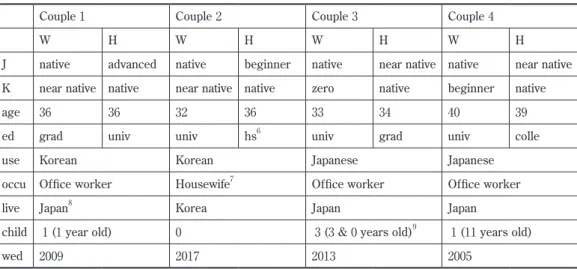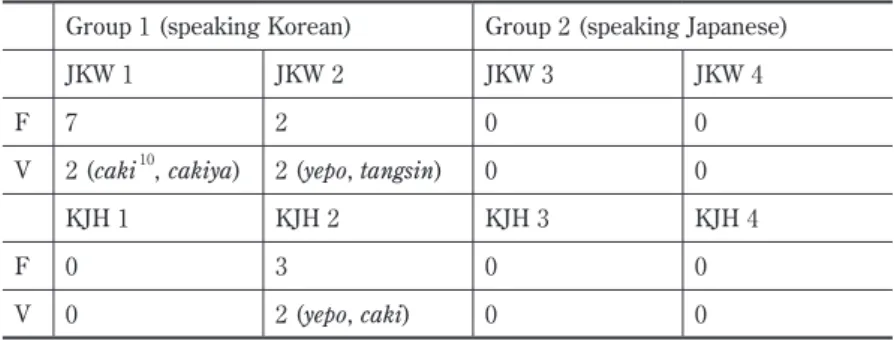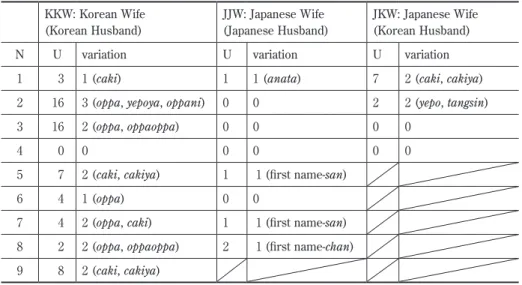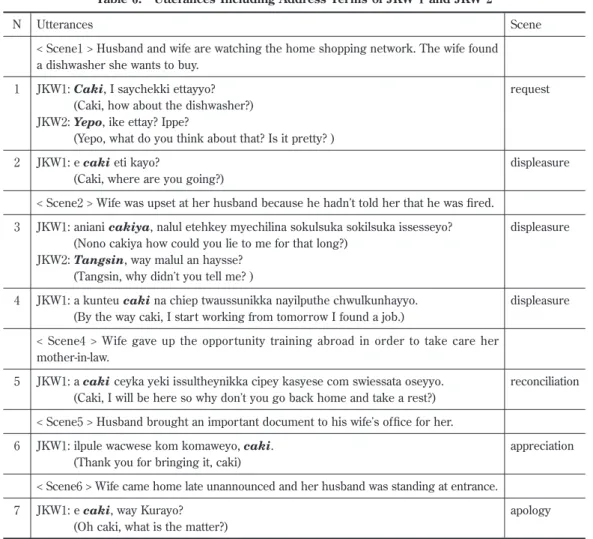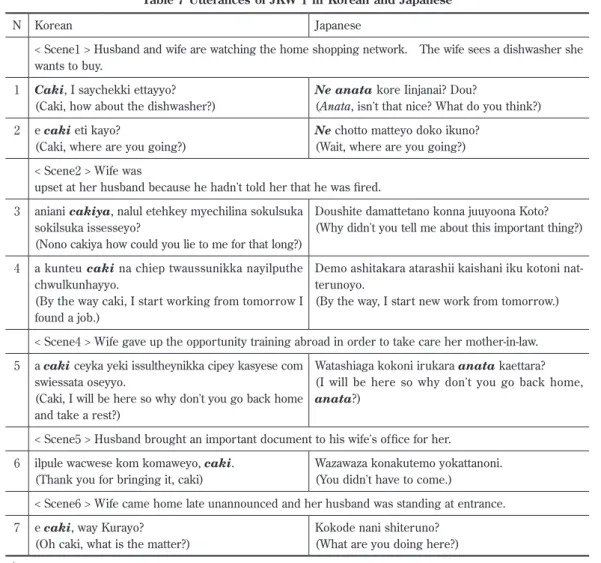Technical Internship Training Program, 1992–2017
1. Introduction
International marriage is increasing both in South Korea and Japan. According to the Korean Statistical Information Service, from ₂₀₀₀ to ₂₀₁₈ the overall rate of marriage in South Korea decreased by ₂₂.₄%. At the same time, the rate of Korean men marrying foreign women increased by ₁₃₉.₁%, and the rate of Korean women marrying foreign men increased by ₃₀.₇%
₁. In ₁₉₈₀, marriages between Japanese nationals and foreign nationals composed ₁% of all marriages in Japan. As of ₂₀₁₃, this increased to ₃.₃%, according to the Ministry of Health, Labor, and Welfare
₂. ₈% and ₃.₄% of marriages in ₂₀₁₆ were inter- national marriages in South Korea and Japan, respectively.
Table ₁ and ₂ show foreign spouses' nationality in South Korea and in Japan in ₂₀₁₅.
Japanese nationals (both men and women) were the third-largest group of foreign nationals married to Korean nationals in Korea in ₂₀₁₅. Similarly, Korean nationals were
Address Terms of Korean-Japanese International Married Couples:
Focusing on Korean Husbands and Japanese Wives
Sumi Yoon
(Received on May ₃₁, ₂₀₁₉)
Abstract
The present study examines the use of address terms in conversations between Korean-Japanese international married couples focusing on two groups of Japanese wives
₁) who communicate in Korean with their husbands and ₂) who speak Japanese to their husbands. The present study demonstrates that regarding the number and variations of address terms used in conversations, Japanese wives who speak Korean to their Korean husbands use a wider range than those who speak Japanese. For verification, I also com- pare the results to Korean wives whose husbands are also Korean and Japanese wives whose husbands are Japanese. The address terms used by Japanese wives who commu- nicate in Korean with their Korean husbands are very similar to Korean national wives whose husbands are Korean.
₁ Korean Statistical Information Service (KOSIS). www.kosis.kr
₂ Ministry of Health, Labor and Welfare Japan, "Statistics on Demographic Change". www.e-ta.go.jp
the third-largest group (women) and the largest group (men) of foreign nationals married to Japanese nationals in Japan in ₂₀₁₅.
Compared to international marriages between Korean or Japanese men and foreign women from China or Southeast Asia, research has not focused on the linguistic and social issues within Korean-Japanese international marriages. This may be partly due to the fact that Korea and Japan share many similarities linguistically, geographically, economically, and historically. However, it has been found that there are constant misunderstandings and linguistic frictions between Korean and Japanese speakers. Researchers that focus on marriages between Koreans and non-Koreans (Japanese and non-Japanese) do so because of the tensions created by unions made out of economic considerations rather than romantic considerations.
Yoon (₂₀₀₉) compared real conversations of Korean married couples and Japanese married couples and found that regarding the number and variations of address terms
₃ Including Korean passport holders such as zainichi (Korean Japanese).
Table 1. Number of Foreign Nationals Married to Korean Nationals in Korea in 2015
Rank H :Korean, W: Non-Korean No. W: Korean, H: Non-Korean No.
₁ Vietnam ₄,₆₅₁ USA ₁,₆₁₂
₂ China ₄,₅₄₅ China ₁,₄₃₄
₃ Japan ₁,₀₃₀ Japan ₈₀₈
₄ The Philippines ₁,₀₀₆ Canada ₄₆₅
₅ USA ₅₇₇ Vietnam ₄₃₂
*H: Husband, W: Wife
Table 2. Number of Foreign Nationals Married to Japanese Nationals in Japan in 2015
Rank H: Japanese, W: Non-Japanese No. W: Japanese, H: Non-Japanese No.
₁ China ₅,₇₃₀ Korea ₁,₅₆₆
₂ The Philippines ₃,₀₇₀ USA ₁,₁₂₇
₃ Korea₃ ₂,₂₆₈ China ₇₄₈
₄ Thailand ₉₃₈ Brazil ₃₄₄
₅ Brazil ₂₇₇ UK ₂₃₅
*H: Husband, W: Wife
used in conversations, Korean married couples utter address terms more often and use a wider range of address terms than Japanese married couples. In other words, Japanese address their spouses when they need to call attention, while Korean couples use address terms strategically as contextualization cues (Gumperz, ₁₉₈₂) in communication between husbands and wives to achieve a communicative purpose, e.g. to make a request clear.
Address term
₄is a word or expression used in interactive, dyadic and face-to-face situ- ations to designate the person being talked to (Oyetade, ₁₉₉₅). Address terms are usu- ally used to focus attention on the interlocutor for a linguistic interaction. In sociolinguis- tics, address terms have been studied as interactional phenomena in terms of politeness and other social or cultural values in many languages
₅.
After the French tu and vous (Brown and Gilman, ₁₉₆₀), the second person plural pronoun of address were focused on in many languages regarding politeness (Brown and Levinson, ₁₉₈₇). In Korean and Japanese, address terms have been focused on regarding politeness. Both Korean and Japanese have honorific systems and the choice of address terms depends on the relationship between the speaker and hearer. In Korean and Japanese, address terms of married couples were classified linguistically and socio-linguistically according to different generations or different languages (Nagura, ₁₉₉₂; Hong, ₂₀₀₇).
However, address terms between married couples as contextualization cues have been less studied in both languages.
The number of international marriages between Korean and Japanese is increasing these days. It is very interesting to analyze what address terms are used and how strate- gically the address terms are used (or omitted) in conversations between Korean and Japanese international married couples, since their backgrounds are different not only in terms of language but also the ways address terms are used in conversation.
₄ The term 'address terms' in the present study indicates the 'free form of addressing' in Braun (₁₉₈₈). According to Braun, the use of address terms is grouped into two types; ₁) referential and ₂) addressing. The referential address terms are used to refer a third person. For example, my wife in the sentence 'My wife is Japanese' is referential. The addressing address terms are used to address an interlocutor directly. For example, Emma (free form) and you (bound form) in the sentence 'Emma, how are you?' are both addressing.
₅ Swann Joan, Deumert Ana, Lillis Theresa & Mestherie Rajend (₂₀₀₄). A dictionary of Sociolinguistics. Edinburgh University Press.
2. Methods
2.1. Procedure
I selected four scenes from one Korean and one Japanese TV show that contained conversations between married couples. The Korean show is a remake of the Japanese one, therefore they are thematically similar. I also set up role play situations based on the TV shows, using directives (i.e. make an apology for coming home late) to make the par- ticipants verbally react to the role play situations.
I prepared two different versions of directives for the role play, in Korean and Japanese, and asked the couples which version they want to use. Two couples who speak in Korean to each other chose the Korean version and did the role play in Korean and the other two couples who speak in Japanese at home chose the Japanese version and did the role play in Japanese. A Japanese wife who communicates in Korean with her Korean husband was asked to make the same conversation twice, in Korean and Japanese.
In ₂₀₁₇, from April to August, sixteen Korean conversations (by couple ₁ and ₂) and
₁₆ Japanese conversations (by couple ₃ and ₄) were audio-recorded and transcribed for the analysis. In order to check the validity of the data collected for the present study, I asked several questions in reference to address terms (e.g. what do you call each other usually?) at a follow-up interview. The participants were not told about the aims of this research and not encouraged to use any address terms in the instructions before the follow-up interview.
2.2. Participants
The participants of the present study are four heterosexual married couples, where the wives are Japanese and the husbands are Korean. Table ₃ shows the participants'
information.
The participants of this research are Japanese (wives) and Korean (husbands) inter-
national married couples in their ₃₀'s to ₄₀'s, living in Korea and Japan, and junior college
or university educated. Couple ₁ and ₂ communicate in Korean and couple ₃ and ₄ speak
in Japanese to each other. Only couple ₂ live in Korea and the husband has never lived
in Japan.
3. Results and Discussion
3.1. Frequency and Variation
The results are presented below in Table ₄. The Japanese wives (JKW ₁ and ₂) who have conversations in Korean with their Korean husbands used address terms seven times and twice, respectively. In terms of variation of address terms both JKW ₁ and ₂ used two different address terms in the conversations. The address terms used by JKW ₁ and ₂ are Korean address terms usually used by both wives (or girlfriends) and husbands (or boyfriends) toward each other.
Only KJH ₂ used address terms in the short conversation with his wife. He uttered address terms three times and used two different variations of address terms. KJH ₁, who also speaks Korean with his Japanese wife, told at the follow-up interview that he usu- ally addresses his wife by her first name + ya. He tried not to use the address term dur- ing the research because the conversation was being recorded and he was concerned
Table 3. Information of Participants
Couple ₁ Couple ₂ Couple ₃ Couple ₄
W H W H W H W H
J native advanced native beginner native near native native near native K near native native near native native zero native beginner native
age ₃₆ ₃₆ ₃₂ ₃₆ ₃₃ ₃₄ ₄₀ ₃₉
ed grad univ univ hs₆ univ grad univ colle
use Korean Korean Japanese Japanese
occu Office worker Housewife₇ Office worker Office worker
live Japan₈ Korea Japan Japan
child ₁(₁ year old) ₀ ₃(₃ & ₀ years old)₉ ₁(₁₁ years old)
wed ₂₀₀₉ ₂₀₁₇ ₂₀₁₃ ₂₀₀₅
*J: Japanese language, K: Korean language, W: Wife, H: Husband, ed: education, occu: occupation, wed: wedding year
₆ The husband dropped out of university after a couple of years.
₇ The wife used to work at a university as an office staff in Japan before moving to Korea to get married in ₂₀₁₇.
₈ The couple met and got married in Korea. The wife moved to Japan with her husband after she lived in Korea for ₁₀ years.
₉ The three-year-old children are twins.
about privacy.
JKW ₃ and ₄, who speak Japanese with their Korean husbands (KJH ₃ and ₄), did not use any address terms. JKW ₃ has never studied Korean nor lived in Korea. She used to call her husband 'last name - kun
₁₁' before their first kids were born. After their birth, she started calling her husband 'papa'. However, she tries to avoid using this address term because her husband doesn't like to be called 'papa'
₁₂.
Fujii (₂₀₁₂) pointed out that the phenomenon of the 'zero' form of address terms from husband to wife in Japanese can be explained by the concept of amae, in which the "hus- band and wife are one mind, same body" (huuhuwa issin dootai) (Fujii, ₂₀₁₂: ₃₁). The same expression exists in Korean (pwupwunun lisimtongchey), i.e., the notion that husband and wife are non-separable. Therefore, the difference in use of address terms is more likely to be explained by the different functions of address terms as contextualization cues in a conversation rather than the notion of the relationship between husband and wife.
Considering the results of the present study, it can be assumed that JKW ₁ and ₂ learned the function of address terms in Korean as they studied the Korean language, since I did not see any relationship in differences between couples ₁ and ₂, and couples ₃
Table 4. Address Terms Used in Conversations by Japanese Wives and Korean Husbands
Group ₁ (speaking Korean) Group ₂ (speaking Japanese)
JKW ₁ JKW ₂ JKW ₃ JKW ₄
F ₇ ₂ ₀ ₀
V ₂ (caki₁₀, cakiya) ₂ (yepo, tangsin) ₀ ₀
KJH ₁ KJH ₂ KJH ₃ KJH ₄
F ₀ ₃ ₀ ₀
V ₀ ₂ (yepo, caki) ₀ ₀
*JKW: Japanese wife whose husband is Korean, KJH: Korean husband whose wife is Japanese, F: Frequency, V: Variation
₁₀ The yale system is used for Korean in the present study.
₁₁ 'kun' is a honorific title marker that is usually added after a same age or younger person's first name or last name in Japanese.
₁₂ 'papa' is daddy in Japanese. Japanese married couples call each other 'mom' or 'dad' usually.
However, it is not common for spouses in Korea to use 'dad' or 'mom'. As a Korean, I started to become interested in address terms between married couples in Japanese after I heard an elderly man call his wife 'mother' at a supermarket in Japan.
and ₄; the wives are all Japanese and their husbands are all Korean.
Table ₅ shows the results of Yoon (₂₀₀₉) and the present study.
The results show that Korean-speaking Japanese wives (of Korean husbands, JKW₁ and ₂) use of address terms is very similar to Korean wives whose husbands are also Korean (Yoon, ₂₀₀₉). Japanese-speaking Japanese wives (of Korean husbands, JKW₃ and
₄) use address terms similarly to Japanese wives whose husbands are also Japanese (Yoon,
₂₀₀₉). The features of the participants in Yoon (₂₀₀₉) are the same as participants of the current study. Regarding the residence, all the Korean and Japanese participants (Yoon,
₂₀₀₉) were living in the capital spheres Seoul and Tokyo respectively.
As Table ₃ shows, the results of Korean wives and Japanese wives who communicate in Korean with their Korean husbands are very similar. JKW and KKW tend to use two or more variations of address terms and utter them more than twice. The results of Japanese wife (JKW ₁) whose husband is from Korea, and KKW ₅ are exactly the same.
Both wives uttered address terms seven times and used two different variations, caki and cakiya.
The results of JKW ₃ and ₄ are very similar to the results of Japanese wives whose husbands are also Japanese in Yoon (₂₀₀₉): JJW ₂, ₃, and ₆, and JKW ₁ and ₂ didn't use any address terms.
Table 5. Address Terms Used in Conversations by Korean and Japanese Wives KKW: Korean Wife
(Korean Husband)
JJW: Japanese Wife (Japanese Husband)
JKW: Japanese Wife (Korean Husband)
N U variation U variation U variation
₁ ₃ ₁ (caki) ₁ ₁ (anata) ₇ ₂ (caki, cakiya)
₂ ₁₆ ₃ (oppa, yepoya, oppani) ₀ ₀ ₂ ₂ (yepo, tangsin)
₃ ₁₆ ₂ (oppa, oppaoppa) ₀ ₀ ₀ ₀
₄ ₀ ₀ ₀ ₀ ₀ ₀
₅ ₇ ₂ (caki, cakiya) ₁ ₁(first name-san)
₆ ₄ ₁ (oppa) ₀ ₀
₇ ₄ ₂ (oppa, caki) ₁ ₁(first name-san)
₈ ₂ ₂ (oppa, oppaoppa) ₂ ₁(first name-chan)
₉ ₈ ₂ (caki, cakiya)
*KKW: Korean Wife whose husband is Korean, JJW: Japanese Wife whose husband is Japanese, JKW: Japanese Wife whose husband is Korean, N: Number, U: Use
3.2. The Function of Address Terms in Korean Conversations
After analyzing the situation where address terms are uttered in conversations between Korean married couples, Yoon (₂₀₀₈) showed that address terms are used for signaling a speaker's emotion and controlling the interlocutor's emotions in Korean conversations. According to Yoon (₂₀₀₈), address terms are used in discourses such as requests, appreciation, apologies, and displeasure.
Table ₆ is the list of utterances that included address terms uttered by JKW ₁ and JKW ₂.
JKW ₁ has studied Korean for approximately ₂₀ years, including majoring in Korean
Table 6. Utterances Including Address Terms of JKW 1 and JKW 2
N Utterances Scene
< Scene₁ > Husband and wife are watching the home shopping network. The wife found a dishwasher she wants to buy.
₁ JKW₁: Caki, I saychekki ettayyo?
(Caki, how about the dishwasher?) JKW₂: Yepo, ike ettay? Ippe?
(Yepo, what do you think about that? Is it pretty? )
request
₂ JKW₁: e caki eti kayo?
(Caki, where are you going?)
displeasure
< Scene₂ > Wife was upset at her husband because he hadn't told her that he was fired.
₃ JKW₁: aniani cakiya, nalul etehkey myechilina sokulsuka sokilsuka issesseyo?
(Nono cakiya how could you lie to me for that long?) JKW₂: Tangsin, way malul an haysse?
(Tangsin, why didn't you tell me? )
displeasure
₄ JKW₁: a kunteu caki na chiep twaussunikka nayilputhe chwulkunhayyo.
(By the way caki, I start working from tomorrow I found a job.)
displeasure
< Scene₄ > Wife gave up the opportunity training abroad in order to take care her mother-in-law.
₅ JKW₁: a caki ceyka yeki issultheynikka cipey kasyese com swiessata oseyyo.
(Caki, I will be here so why don't you go back home and take a rest?)
reconciliation
< Scene₅ > Husband brought an important document to his wife's office for her.
₆ JKW₁: ilpule wacwese kom komaweyo, caki.
(Thank you for bringing it, caki)
appreciation
< Scene₆ > Wife came home late unannounced and her husband was standing at entrance.
₇ JKW₁: e caki, way Kurayo?
(Oh caki, what is the matter?)
apology
*JKW: Japanese Wife whose husband is Korean, N: Number
language at a university in Japan and a graduate school in Korea. After living in South Korea for about ₁₀ years, she moved back to Japan with her Korean husband four years ago (at the time the conversations were collected). They have one son and speak only Korean at home.
JKW ₂ studied Korean at a university in Japan. After her graduation from the univer- sity, she worked at a Japanese company and had to use Korean frequently. She met her Korean husband in Korea when she visited Korea on a business trip. She also moved to Korea to get married. She now lives in Korea with her husband.
Both JKW ₁ and ₂ used address terms at scene ₁ (utterance number ₁) and scene ₂ (utterance number ₃). Utterance number ₁ was said to convey that she intended to buy the dishwasher (actually she had already ordered it), rather than asking for her husband'
s opinion. JKW ₁ and ₂ used caki and yepo, respectively. Both caki and yepo are address terms used between lovers or married couples in Korean, and can be translated into Eng- lish has 'honey' or 'darling'.
In utterance number ₃, the wife is upset at her husband because he hadn't told her that he had been fired for a long time. She is questioning the reason why he didn't tell her. Both JKW ₁ and ₂ used address terms at utterance number ₃ which are different than the ones used at utterance number ₁.
JKW ₁ switched from caki to cakiya (utterance number ₃, displeasure). As described in ₃.₁., caki literally means oneself but it can also be translated as 'honey' or 'darling' when it is used by couples. Cakiya consists of caki + ya, ya here is a title marker that is usually added after the interlocutor's first name when addressing a subordinate. Compared to caki, cakıya can be considered an expression of intimacy or the displeasure of the speaker toward the interlocutor. JKW ₁ usually calls her husband caki
₁₃. However, cakiya is used to signal her unpleasant emotions toward her husband.
Utterances (₁) and (₂) were uttered by JKW ₁ and KKW ₁ (Yoon, ₂₀₀₉) below.
< Scene₂ > Wife was upset at her husband because he hadn't told her that he was fired.
(₁) JKW₁: aniani cakiya, nalul etehkey myechilina sokulsuka sokilsuka issesseyo?
₁₃ Only caki and cakiya were uttered in the conversations of the present study, however, I learnt that she calls him with many variations. Usually caki and first name + ssi. 'ssi' is a title marker that is added after a same age or older person's first name or full name.
(No, no, cakiya how could you lie to me for that long?)
(₂) KKW₅: kulem ikey haykyel toyn keya? Kulen mence nahanthey sanguylul hayyaci cakiya. Wulin pwupwucanha.
(Did you think it wouldn't be a problem? You should have told me immedi- ately, cakiya. We are a married couple. )
It is interesting that both of wives used the same address term cakiya at the same scene (more precisely at the same utterance). As shown in table ₃ above, like JKW ₁, KKW ₅ also used caki, and cakiya.
JKW ₂ switched from yepo to tangsin (at utterance number ₃, displeasure). Yepo and tangsin are address terms used by couples, which can be translated into English as 'honey'
or 'darling'. However, the word tangsin is also used when the speaker wants to belittle the interlocutor. Furthermore, compared to yepo, tangsin puts distance between a speaker and his/her interlocutor. Regarding the use of address terms as contextualization cues, it was clarified again by the Japanese wives who are Korean language learners.
Finally, JKW ₁ and JKW ₂ uttered caki and cakiya, and yepo and tangsin as free forms of address term, respectively. It is interesting that tangsin and caki were used as bound forms, second-person pronoun, of address terms as shown (₃) and (₄) below.
< Scene₂ > Wife came home late unannounced and her husband asked why she didn't call him to tell that she is going to be late.
(₃) JKW ₁: Tanshin-to ilel ttay cenhwa hay ponceki epscanhayo.
(Tanshin never called me either.)
(₄) JKW ₂: Caki-to cenhwaycwun cek epsesscanha.
(Caki never called me either.)
3.3. JKW 1’s Koran and Japanese
I asked JKW ₁ to do the role play again in Japanese
₁₄because the husband under- stands Japanese even though they don't speak in Japanese to each other to find out how
₁₄ The husband didn't do it so I did the husband's part in Japanese.
the address terms are translated (or not translated). Table ₇ is a list of utterances includ- ing address terms of JKW₁ in Korean and the Japanese version of the utterances.
As described above, JKW ₁ used two different address terms seven times in Korean, however she uttered address terms ne
₁₅and anata
₁₆four times at utterances number ₁, ₂, and ₅ in Japanese. Both ne and anata can be used between married couples in Japanese.
₁₅ An interjection. It is used when address someone who is the same age or younger than the speaker. It also can be used toward an intimate superior.
₁₆ The second pronoun. Anata is only polite between equals or when referring to a junior (Nagura,
₁₉₉₂). Anata is used by a wife to address her husband.
Table 7 Utterances of JKW 1 in Korean and Japanese
N Korean Japanese
< Scene₁ > Husband and wife are watching the home shopping network. The wife sees a dishwasher she wants to buy.
₁ Caki, I saychekki ettayyo?
(Caki, how about the dishwasher?)
Ne anata kore Iinjanai? Dou?
(Anata, isn't that nice? What do you think?)
₂ e caki eti kayo?
(Caki, where are you going?)
Ne chotto matteyo doko ikuno?
(Wait, where are you going?)
< Scene₂ > Wife was
upset at her husband because he hadn't told her that he was fired.
₃ aniani cakiya, nalul etehkey myechilina sokulsuka sokilsuka issesseyo?
(Nono cakiya how could you lie to me for that long?)
Doushite damattetano konna juuyoona Koto?
(Why didn't you tell me about this important thing?)
₄ a kunteu caki na chiep twaussunikka nayilputhe chwulkunhayyo.
(By the way caki, I start working from tomorrow I found a job.)
Demo ashitakara atarashii kaishani iku kotoni nat- terunoyo.
(By the way, I start new work from tomorrow.)
< Scene₄ > Wife gave up the opportunity training abroad in order to take care her mother-in-law.
₅ a caki ceyka yeki issultheynikka cipey kasyese com swiessata oseyyo.
(Caki, I will be here so why don't you go back home and take a rest?)
Watashiaga kokoni irukara anata kaettara?
(I will be here so why don't you go back home, anata?)
< Scene₅ > Husband brought an important document to his wife's office for her.
₆ ilpule wacwese kom komaweyo, caki.
(Thank you for bringing it, caki)
Wazawaza konakutemo yokattanoni.
(You didn't have to come.)
< Scene₆ > Wife came home late unannounced and her husband was standing at entrance.
₇ e caki, way Kurayo?
(Oh caki, what is the matter?)
Kokode nani shiteruno?
(What are you doing here?)
*N: Number
At the follow-up interview, she said that even though they don't speak Japanese at home they sometimes have to speak to each other in Japanese, for example when they visit the wife's family members who have no knowledge of Korean. In that kind of situation, JKW
₁ usually calls her husband ne, anata, and first name + san
₁₇.
Besides of the use of address terms, there is an interesting difference between JKW ₁'
s utterances in Korean and Japanese. Honorifics are used in Korean but normal forms are used in Japanese. Because she learned Korean as a foreign language, it is easier to speak honorific Korean for her, she said at the follow-up interview. She also mentioned another reason related to the cultural difference between Korea and Japan. In Korea, many couples tend to introduce their girlfriends or boyfriends to their parents at an early stage of dating.
She met her husband (boyfriend at that time)'s parents right after they started dating, and she thought the traditional parents would like her better if she used honorifics to him. And the parents really liked it. After that she has been using honorifics in Korean even though they are same age.
4. Conclusions
Regarding the frequency and variations of address terms used in conversations between married couples, Japanese wives who communicate in Korean with their Korean husbands tend to utter a wider variety of address terms more often than Japanese wives whose husbands are Korean but who speak Japanese at home. The former used address terms similarly to Korean native speakers as contextualization cues, such as conveying the speaker's emotions to the interlocutor. They learned how important the function of address terms in Korean is in order to smooth the communication with acquaintances, friends, and husbands.
I was only able to gather information from four different intercultural couples. How- ever, we can start to see how the use of address terms are influenced by participants'
background in some detail. In the future, I hope to expand my pool of participants. I would also like to investigate how intercultural couples navigate decisions regarding address terms, since they are so important to discourse and mutual understanding.
₁₇ 'san' is a honorific title marker that is usually added after first name or last name in Japanese.
References
Braun, Friederike (₁₉₈₈). Terms of Address. Berlin; New York; Amsterdam; Mouton de Gruyter.
Brown, Penelope & Levinson, Stephen C. (₁₉₈₇). Politeness: Some universal in language usage.
Cambridge: Cambridge University Press.
Brown, Roger & Gilman, Albert. (₁₉₆₀). The Pronouns of Power and Solidarity. In Sebeok, T. A.
(ed.), Style in Language, ₂₅₃–₂₇₆. Cambridge, Mass: MIT Press.
Fujii, Yoko (₂₀₁₂). Social indexicality of the "zero" form of address terms in Japanese: The interpre- tation from the Amae concept on the basis of "inseparable self and the other".
Nihonjoshidaigakukiyo. Bungakubu [Memoirs of the Japan Women's University. Faculty of Literature], ₆₂, pp. ₂₃–₃₄.
Gumperz, John J. (₁₉₈₂). Discourse Strategies. Cambridge: Cambridge University Press.
Hong, Minpyo. (₂₀₀₇). Nikkan ryookoku no gengokoodo no chigai – fuufu kosho no nikkann hikaku – [Differences of linguistic behaviors between Japan and Korea – A comparison of address terms of married coupe – ]. Nihongogaku ₂₆(₂), pp. ₈₀–₉₂.
Inoue, Ippei (₂₀₀₃). Kotobano Seitaikei: komyunikeishon-wa nanide dekiteiruka [An ecological system of language: What consist of communication?]. Yokohama: Keiogijukudaigaku shuppankai.
Nagura, Toshie. (₁₉₉₂). The Use of Address Terms between Japanese Spouses. Sekainonihongo- kyoiku [Japanese-language education around the globe] ₂, pp. ₄₅–₆₃.
Oyatade, Oluwole S. (₁₉₉₅). A sociolinguistic analysis of address forms in Yoruba. Language in Society ₂₄, pp. ₅₁₅–₅₃₅.
Swann, Joan., Deumert, Ana., Lillis, Theresa & Mesthrie, Rajend (₂₀₀₄). A Dictionary of Sociolinguistics. Edinburgh: Edinburgh University Press.
Yoon, Sumi (₂₀₀₈). Comparison between Koran and Japanese Address Terms as Contextualization Cues in Husband-Wife's Dialogues. Inquiries into Korean Linguistics, ₃, pp. ₃₇₇–₃₈₇.
Yoon, Sumi (₂₀₀₉). A Contrastive Study of Metacommunicative Functions of Address Terms between Husband and Wife in Korea and Japan. Current Issue in Unity and Diversity of Lan- guage: Collection of the Papers Selected from the Interactional Congress of Linguists (CIL), ₁₈, pp.
₃₈₁₉–₃₈₃₁.

